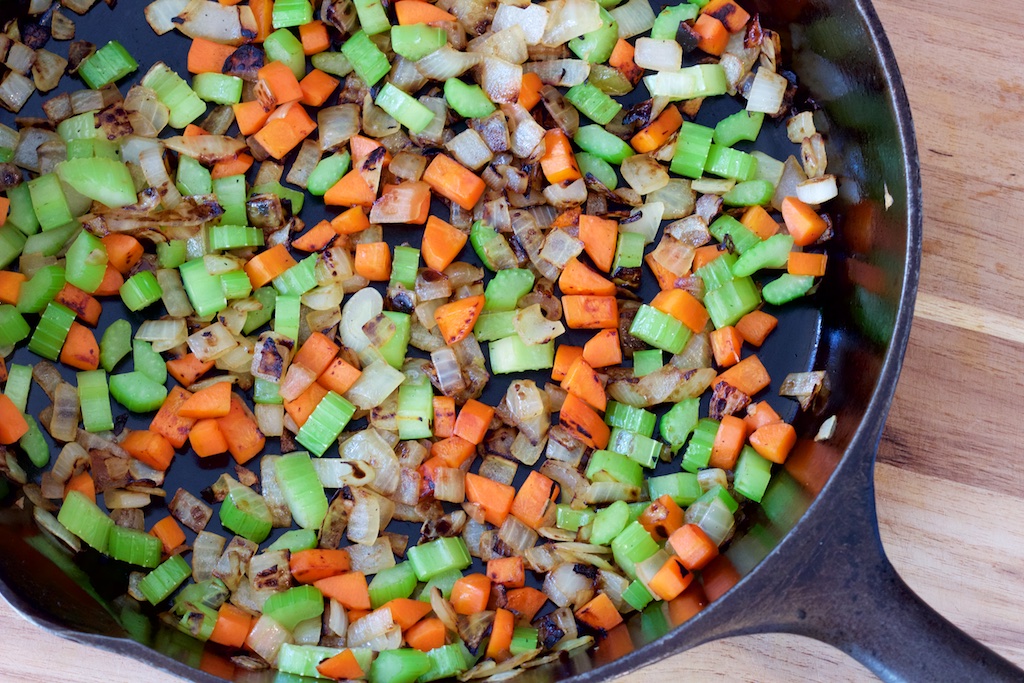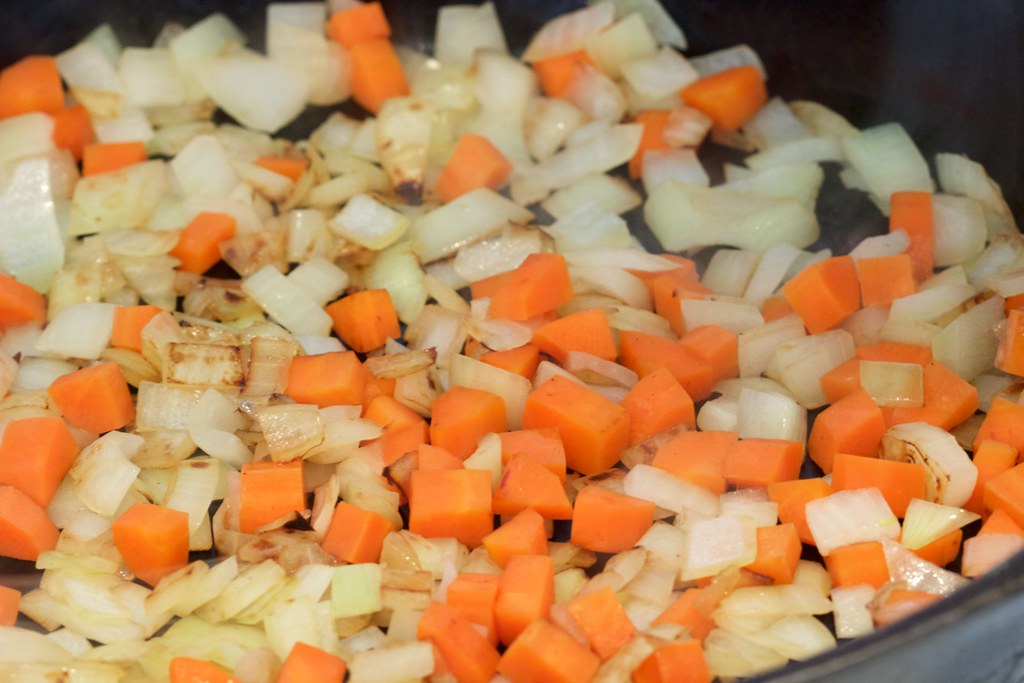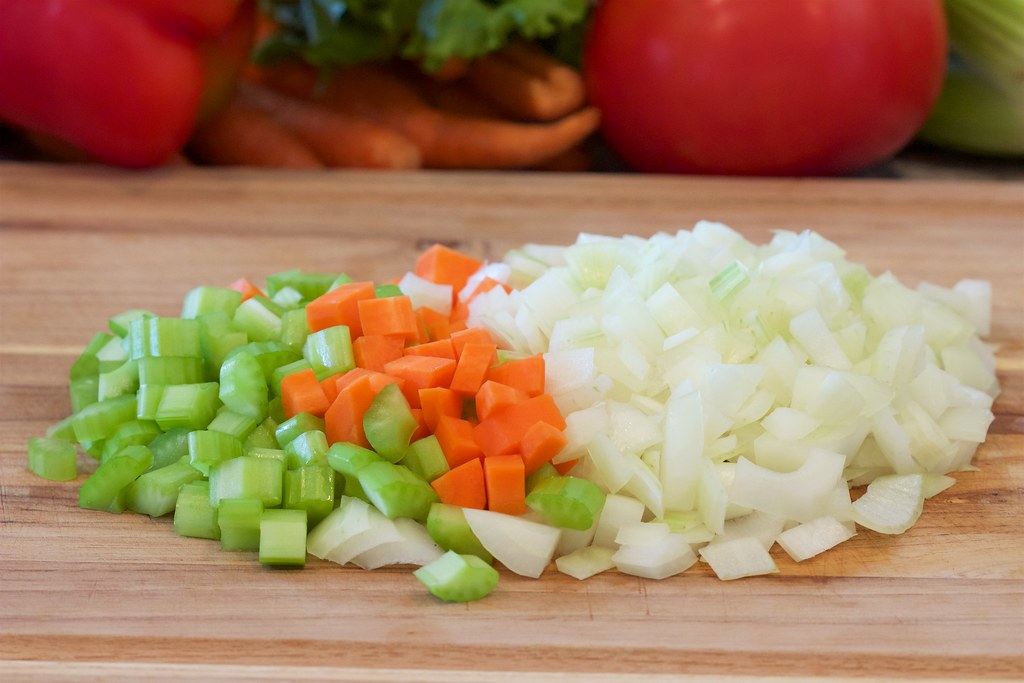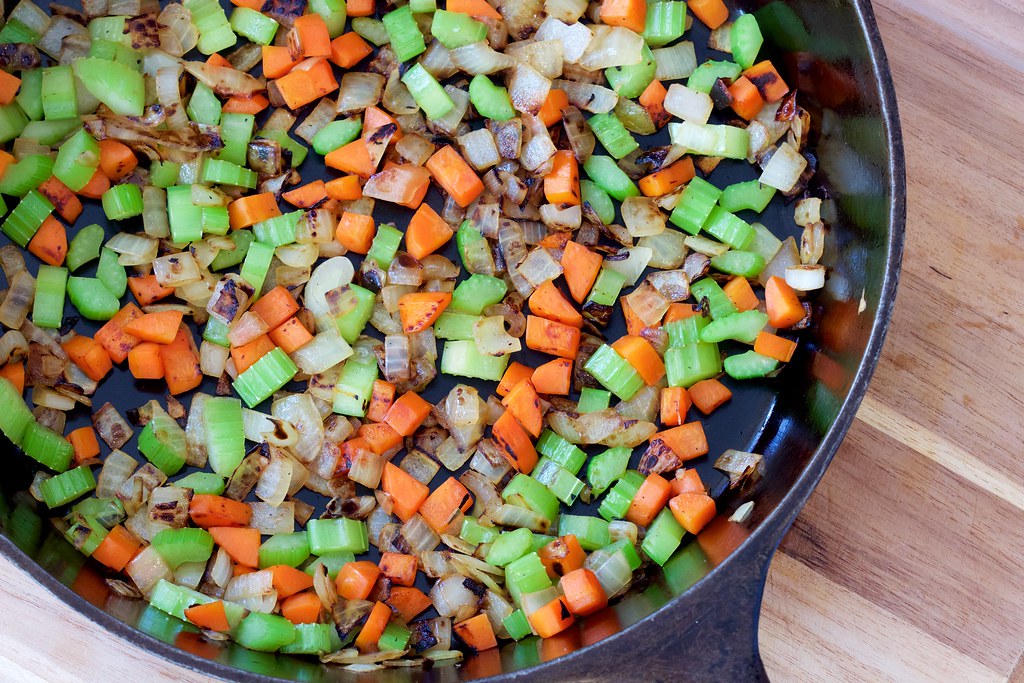At its most basic, the standard mirepoix (pronounced “mihr-PWAH” or “meer PWAH”) is a mixture of onions, carrots, and celery sautéed in butter. It’s used as an aromatic, flavorful addition to foods ranging from soups and sauces to braised meats and marinades. Chefs around the world also refer to it as “The Holy Trinity,” and it can be used in oh so many ways.
Prepare a standard mirepoix by using a 2:1:1 ratio of onions, carrots, and celery. In percentages, that’s 50% onion, 25% carrot, and 25% celery.
It’s okay to switch up the ratio to create different flavor variations. If you’re not big on exactly measuring stuff, it’s approximately 1 yellow onion, 1 large carrot, and 2 celery ribs.
A common, quick way to cook mirepoix is to brown the onions and carrots together on medium-high heat (sauté) and then add the celery, cooking until soft. This develops a deeper flavor profile, and is especially delicious in soups. Again, you may choose another method depending on what you’re cooking. Any recipe that uses a mirepoix variation should give you specific instructions. If it doesn’t, assume the method above is used.
Determine the Size of Cut
The size you cut your vegetables should be relative to the amount of time they’ll spend cooking. The smaller cut your vegetables are, the faster they’ll release their aromas. For example, if you’re making a…
Whatever the case, be at ease. Most recipes will tell you what to do. If not, do your best to think of the end dish and the result you want, and go from there. If it doesn’t work out, try again next time.
Mirepoix: Peeling Not Required
Most of the time I peel my carrots and onions when making a mirepoix, although it’s not always required (e.g. making a stock or roasting). If you don’t peel them, at least be sure to give them a nice scrubbing. Because I often include the mirepoix in my final dish, I like to peel them for looks if not anything else.
Some people claim that removing the peels from your vegetables also helps them impart their aromas more easily. I have no idea if that’s true or not and haven’t bothered to test it. Onion skins will add a tint of color to your food, so it’s up to you if you include them or not. (Along those lines, carrots will add an orange color to your food.)
Mirepoix: A Mire Bit O’ History
Mirepoix is of French origin. I don’t speak French which means I often stumble over these darned foreign words. Sometimes I wonder how different the culinary world would be if the Germans had coined all our culinary phrases. Maybe there would be a lot more accidental spit in our food. Lame guttural spit jokes aside, I do love German food, and it’s not as if French is any easier for me.
Mirepoix has an interesting history. I’ll try to sum it up lickety-split.
<– Queue Morgan Freeman’s voice. –>
Near France’s Southern border, there’s a small town named Mirepoix. Rewind the time back a few hundred years to the 18th century. In this town lived Gaston Pierre de Lévis, a rather ordinary man who was also known as the Duke of Mirepoix. Employed to the Duke was a skilled chef named _____. (For real, his name is unknown.) While historians are sure the Duke’s chef didn’t invent the aromatic mixture, it’s known that he was quite adept at using it. It’s surmised that he’s even the one responsible for making it popular.
As the story goes, the Duke in his great ordinariness needed to leave a legacy, but had nothing of his own to supply. So he did the next logical thing: name the Holy Trinity of foods after himself. I can only imagine Chef _____’s excitement. To this day the name remains, while its champion chef lies forgotten.
<– If you’re still reading in the voice of Morgan Freeman, you can stop now. –>
Go Forth and Conquer
Now that you know and understand the basics of mirepoix, you’re capable of conquering the world. Keep your eyes and taste buds open when eating out, and you’ll notice it all over in the foods you order. The next time you’re cooking, take it for a spin, and it will liven up your soups, stews, meats, and sauces.
Enjoy yourself!







Can you prepare mirepoix and freeze?
Thank you Debbie Chapman
Hi Debbie,
Great question. Mirepoix is one of those things that should not be frozen. Once your carrots reach a certain softness, they’ll turn to mush after they’re thawed again. Same with your celery, although because it’s more fibrous, it won’t turn as mushy as the carrots. Onion does pretty good, though it can develop a slightly woodier texture after being cooked, frozen, and then thawed.
If you’re going to blend it all up in a soup later, you *might* be able to get away with it, but then a lot of the flavors will be lost in the pan it was originally cooked in. Depending on the size, it’d probably take about as long to thaw it as it would to make a new batch anyway.
Hope that helps!
Hey Chris,
I think that you might want to amend the following phrase: “To cook mirepoix, brown the onions and carrots together on medium-high heat (sauté) and then add the celery, cooking until soft.” In a mirepoix, the goal is to sweeten the vegetables on low heat and not to caramelize them over high heat. Your wording choice might confuse someone.
Thanks for the feedback JJ, I appreciate you taking the time to read and comment. Cooking the mirepoix over low heat is indeed a great way to sweeten the vegetables.
good on you deb, thanks for that.
I’m an old feller that likes to cook,will surely try your mirewhatzit thank you.
Mirewhatzit, LOL. I like that.
🤣😂🤣
can you tell some point of use of mire poix
Hey there, start by using it as a base in soups, or for roasting with potatoes, or blend it together in a sauce.
The title says how to make *and use* mirepoix, but I didn’t read much about how to use it. A bit more detail on how to use it in soups or other dishes? It can be used to make stock, but would you just add the cooked mix to any dish?
Someone asked about freezing mirepoix. I have purchased it frozen and it works very well for soups. In fact, I just found an online “recipe” to make mirepoix and freeze it for later use. If you need the veges to retain their texture, it’s not a good idea to freeze it, but it’s certainly fine for soups and similar uses.
Absolutely. Once it’s cooked, just freeze it. Or, freeze it before cooking. You’ll lose some of the flavor no matter what, but freezing before-hand ought to minimize that somewhat.
I make large batches of mirepoix, use an infusion blender to break them down. I place in oversized ice cube trays and freeze. I then place them in freezer bags, about 4 or 6 to a bag. Then when making soup, I just toss a couple of these cubes into the soup, along with all the other ingredients, including some fresh mirepoix. I receive so many compliments for the soup having the BEST flavor! I throw one or two cubes into braises, gravies, stews, anything requiring some wonderful flavor. I can get that “cooked all day” flavor in soups that only took 40 minutes to prepare.
This is a great idea! Thanks for sharing!
What if you put the Mirepoix in a large bottle of White/red wine for 2 – 4 weeks to then slowly cooked off the alcholol? Would you get concentrated Mirepoix flavor on hand?
Doing this would infuse both the wine and the alcohol with each other’s flavors. The issue would be that the vegetables would break down, and your wine could spoil before then. If you’re looking for a concentrated flavor, you’d be better of just using spices, or drying the mirepoix ingredients and pulverizing them in a food processor or mortar and pestle.
How much butter????
Hi Shadow,
That depends on the size of your pan, the type of pan, and how much you’re making. I’d keep it scant though for starters. Maybe 1 tbsp.
I use this in my thanksgiving stuffing and it is delic! If I cut it all up and put it in the refrigerator, how long will it last?
Cut and cooked veggies usually last up to a week. Each day they’re stored causes a lot more of a breakdown. For the best experience, I would use the day-of, or the day after.
You mean “its” not “it’s” in your first usage: At it’s most basic, the standard mirepoix (pronounced “mihr-PWAH” or “meer PWAH”) is a mixture of onions, carrots, and celery sautéed in butter.
Great catch, thanks! Fixed.
I missed how long I should cook this mixture.
No specific time, as it can be used for multiple purposes depending on how long you cook it. In general, you’d want to cook it until it starts to brown or is caramelized.